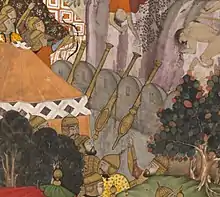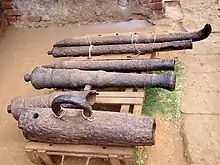
The prangi, paranki, piranki, pirangi, farangi, firingi, or firingiha was a type of cannon produced by the Ottoman Empire. It was subsequently copied and produced in other places such as the Mughal empire under Babur. The prangi was a breech-loading swivel gun.[1]: 143
Etymology

Prangi was written in Ottoman sources in various words as prankı, pirankı, parangi, parangı, pranga, pranku, prangu, and parangu. The Ottoman term goes back to the Italian/Spanish braga, short for "petriero a barga" and "pedrero de braga", a small breech-loading swivel gun.[2]: 100 Braga itself means "pants" or "breech".[1]: 143 Babur called this weapon firingiha and farangi.[3]: 219 Tamil and Telugu speakers call it pīranki and pīrangi.[2]: 100
History and description
Prangi is a small Ottoman breech-loading swivel gun, firing 150 g (5.3 oz) shots, they were built mostly by cast bronze, but iron ones were also used. The Ottomans used the prangi from the mid-15th century onwards in field battles, aboard their ships, and in their forts, where prangis often comprised the majority of the ordnance.[2]: 100 At the end of the 15th century, Ottoman galley were equipped with a big cannon and 4 guns (darbzen) and 8 prangi cannons. These ships were 42–43 m (138–141 ft) long with three sails carrying about 328 people.[4]: 12 Prangi was a standard piece of Ottoman secondary naval armament.[5]: 222 An Ottoman naval record book of inventory and survey dated 10 April 1488 mentioned that Ottoman barça (barque) had 35 prangi, agrıpar (galleas) had 16 prangi, kadırga (galley) had 8 prangi, kalıt (galliot) and kayık (fusta) had 4 prangi.[6]: 173–174
The spread of prangi cannon to the east resulted in the appearance of the western-style cetbang in the Nusantara archipelago after 1460 CE.[7]: 94–95, 98 In China, these cannons are known by the name of Folangji (佛郎机),[1]: 143 Folangji chong (佛郎机铳),[8]: 348–349 or Fo-lang-chi p'ao (佛朗机炮 or 佛朗機砲).[9]: 45 Prangi guns reached China before either Ottoman or Portuguese ships did.[1]: 242 They may have also reached China via the Silk Road.[10]: 131 In the History of the reign of Wan Li (萬厲野獲編), by Shen Defu, it is said that "After the reign of Hong Zhi (1445–1505), China started having Fu-Lang-Ji cannons, the country of which was called in the old times Sam Fu Qi". In volume 30 about "The Red-Haired Foreigners" he wrote "After the reign of Zhengtong (1436–1449) China got hold of Fu-Lang-Ji cannons, the most important magic instrument of foreign people". He mentioned the cannons some 60 or 70 years prior to the first reference to the Portuguese.[11] Pelliot believed that the folangji gun reached China before Portuguese did, possibly by anonymous carriers from Malaya.[12]: 199–207 Needham noted that breech-loading guns were already familiar in Southern China in 1510, as a rebellion in Huang Kuan was destroyed by more than 100 folangji.[13]: 372 It may even be earlier, brought to Fujian by a man named Wei Sheng and used in quelling a pirate incident in 1507.[8]: 348
See also
References
- 1 2 3 4 Chase, Kenneth (2003). Firearms: A Global History to 1700. Cambridge University Press. ISBN 9780521822749.
- 1 2 3 Agoston, Gabor (2019). Firangi, Zarbzan, and Rum Dasturi: The Ottomans and the Diffusion of Firearms in Asia. In Pál Fodor, Nándor E. Kovács and Benedek Péri eds., Şerefe. Studies in Honour of Prof. Géza Dávid on His Seventieth Birthday, Hungarian Academy of Sciences. Budapest: Research Center for the Humanities, 89–104.
- ↑ Partington, J. R. (1999). A History of Greek Fire and Gunpowder. Johns Hopkins University Press. ISBN 9780801859540.
- ↑ Bostan, Idris (2007). Ottoman Maritime Arsenals and Shipbuilding Technology in the 16th and 17th centuries (PDF). Manchester: FSTC Limited.
- ↑ Shai Har-El, Struggle for Domination in the Middle East: The Ottoman-Mamluk War, 1485-1491 (Leiden, New York, and Cologne: E. J. Brill, 1995) Pp. 238. In Mamlūk Studies Review Volume 5.
- ↑ Har-El, Shai (1995). Struggle for Domination in the Middle East: The Ottoman-Mamluk War, 1485-91. E.J. Brill. ISBN 9789004101807.
- ↑ Averoes, Muhammad (2020). Antara Cerita dan Sejarah: Meriam Cetbang Majapahit. Jurnal Sejarah, 3(2), 89 - 100.
- 1 2 Andrade, Tonio (2016). The Gunpowder Age: China, Military Innovation, and the Rise of the West in World History. Princeton University Press. ISBN 978-0-691-13597-7.
- ↑ Charney, Michael (2004). Southeast Asian Warfare, 1300–1900. BRILL. ISBN 9789047406921.
- ↑ Di Cosmo, Nicola. “Did Guns Matter? Firearms and the Qing Formation.” In Lynn Struve, ed., The Qing Formation in World- Historical Time. Cambridge, MA: Harvard University Asia Center, 2004, 121–66.
- ↑ De Abreu, António Graça (1991). "The Chinese, Gunpowder and the Portuguese". Review of Culture. 2: 32–40.
- ↑ Pelliot, Paul (1948). "Le Ḫōj̆a et le Sayyid Ḥusain de l'Histoire des Ming". T'oung Pao. 38: 81–292. doi:10.1163/156853297X00509 – via JSTOR.
- ↑ Needham, Joseph (1986). Science and Civilisation in China, Volume 5: Chemistry and Chemical Technology, Part 7, Military Technology: The Gunpowder Epic. Cambridge: Cambridge University Press.